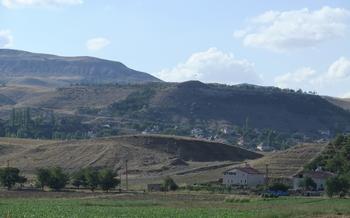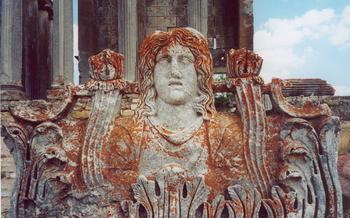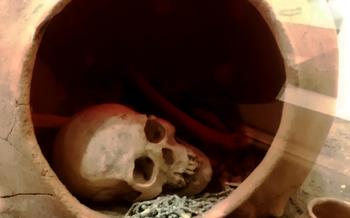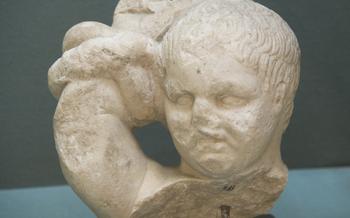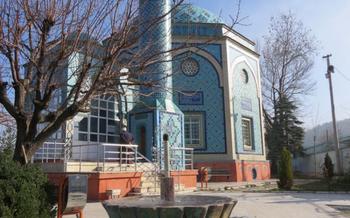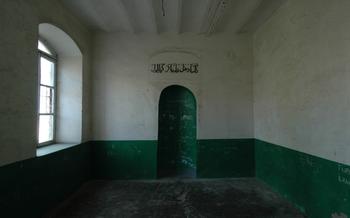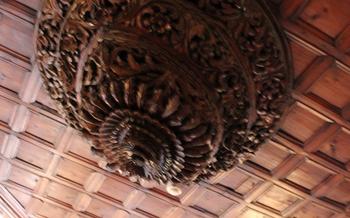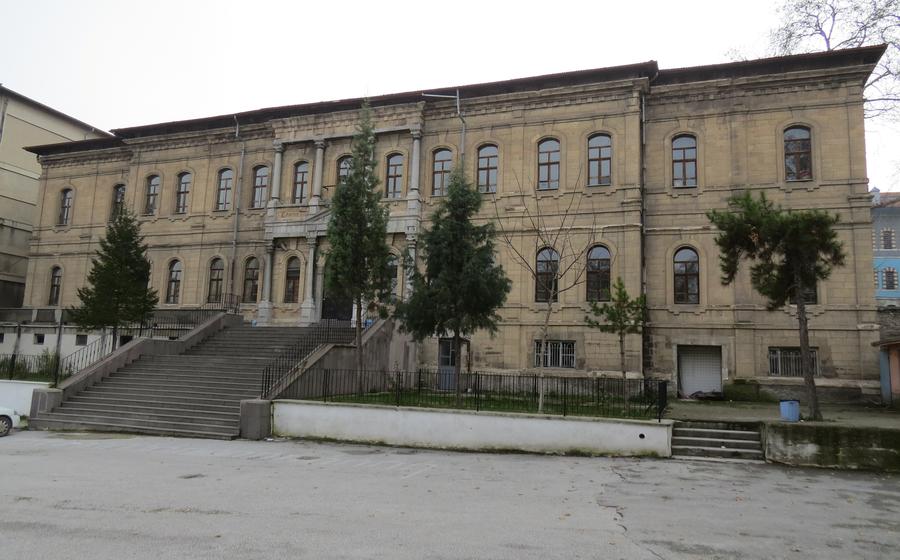
Paphlagonia Antique City
- Exploring the Ruins: A Journey Through Time
- Unveiling the Mosaics: Masterpieces of Art
- The Acropolis: A Majestic Panorama
- The Agora: Center of Ancient Life
- The Theater: Echoes of Ancient Performances
- The Stadium: Arena of Ancient Sports
- The Necropolis: Eternal Resting Grounds
- The Museum: A Treasure Trove of Artifacts
- Local Cuisine: A Taste of Kütahya
- Shopping for Souvenirs: Unique Treasures
- Accommodation Options: Rest and Relaxation
- Transportation: Getting Around Kütahya
- Getting to Kütahya
- Local Transportation
- Renting a Car
- Navigating the City
- Insider Tip
- Insider Tip: Hidden Gem
Exploring the Ruins: A Journey Through Time
Paphlagonia Antique City is a treasure trove of ancient ruins, each with its own story to tell. Begin your journey at the Acropolis, where you'll be greeted by awe-inspiring views of the surrounding countryside. Explore the remains of the city's fortifications and temples, and let your imagination transport you back to a time when gods and goddesses were worshipped here.
Descend from the Acropolis and make your way to the Agora, the bustling center of ancient Paphlagonia. Here, you'll find remnants of shops and public buildings, as well as artifacts and inscriptions that shed light on daily life in this vibrant city.
Don't miss the theater, an architectural marvel that once hosted theatrical performances, musical concerts, and political debates. Marvel at its impressive acoustics and stage layout, and imagine the excitement and energy that filled the air during ancient performances.
Continue your exploration towards the stadium, where athletic competitions and spectacles took place. Envision the roar of the crowd as gladiators battled in the arena or chariots raced around the track.
Finally, visit the baths, a complex of rooms and pools where ancient Romans indulged in relaxation and rituals. Experience the different chambers, from the frigidarium to the caldarium, and understand the social and hygienic significance of these public bathing facilities.
As you wander through the ruins of Paphlagonia Antique City, let the stones whisper their stories and transport you back in time. Each structure, each artifact, and each mosaic offers a glimpse into the lives of the people who called this city home over 2,000 years ago.
Unveiling the Mosaics: Masterpieces of Art
Paphlagonia's mosaics are a testament to the artistry and craftsmanship of its ancient inhabitants. These intricate and colorful artworks adorn the floors and walls of many buildings throughout the city, offering a glimpse into the lives and beliefs of the people who once called this place home.
The mosaics in Paphlagonia were created using a technique called opus tessellatum, in which small, colored tiles, called tesserae, were arranged to form intricate patterns and images. The tesserae were made from a variety of materials, including stone, glass, and ceramic, and were often cut into different shapes and sizes to create a variety of effects.
One of the most notable mosaic artworks in Paphlagonia is the "Hunting Scene", which depicts a group of hunters pursuing a deer in a forest. The mosaic is remarkable for its intricate details and its use of shading to create a sense of depth and movement.
Another notable mosaic is the "Four Seasons", which depicts each of the four seasons personified as a female figure. The mosaic is a beautiful example of the artist's skill in capturing the essence of each season through the use of color and symbolism.
The mosaics in Paphlagonia are a valuable source of information about the city's history and culture. They offer a glimpse into the lives of the people who lived here, their beliefs, and their artistic traditions. These stunning artworks are a must-see for anyone interested in ancient art and history.
The Acropolis: A Majestic Panorama
Perched atop a hill overlooking the ancient city, the Acropolis of Paphlagonia stands as a testament to the city's grandeur and strategic importance. Once the heart of the city's religious and civic life, the Acropolis offers visitors a glimpse into the past and breathtaking panoramic views of the surrounding countryside.
As you ascend the winding path leading to the summit, the remnants of ancient fortifications and temples come into view. Imagine the bustling activity that once took place here, as priests performed rituals and citizens gathered for religious ceremonies and public assemblies. The well-preserved ruins, including the foundations of temples dedicated to various deities, provide a tangible connection to the city's rich history.
Once you reach the summit, you will be rewarded with unrivaled views that stretch across the entire city and beyond. The rolling hills, dotted with olive groves and vineyards, create a picturesque backdrop that transports you back in time. Take a moment to soak in the tranquility and imagine the city's inhabitants gazing upon the same landscape centuries ago.
For photography enthusiasts, the Acropolis offers endless opportunities to capture stunning images. With the ancient ruins as your foreground and the panoramic vistas as your backdrop, you can create breathtaking compositions that will serve as lasting memories of your visit to Paphlagonia.
The Agora: Center of Ancient Life
The agora, or marketplace, was the vibrant heart of ancient Paphlagonia. This bustling hub of commerce and social interaction served as a crucial gathering place for the city's inhabitants. As you explore the agora's well-preserved ruins, you can almost hear the echoes of lively conversations, the clinking of coins, and the laughter of merchants.
Imagine vendors displaying their wares in small shops and stalls, their colorful goods arranged to entice passersby. Artisans demonstrated their skills, crafting intricate pottery, woven textiles, and metalwork before the eyes of admiring customers. The air was filled with the mingled scents of fresh produce, spices, and incense.
Amidst the hustle and bustle, the agora also served as a venue for civic affairs and public gatherings. Important announcements were made, debates were held, and decisions that shaped the city's destiny were reached. The agora was a place where people from all walks of life came together to trade, socialize, and participate in the governance of their community.
As you wander through the agora, take time to admire the architectural features that have stood the test of time. Columns, arches, and intricate stone carvings hint at the grandeur of the buildings that once lined this bustling square. Discover remnants of shops, public buildings, and administrative offices, each offering a glimpse into the daily life of Paphlagonians centuries ago.
The agora is not just a collection of ruins; it's a portal to the past, inviting you to step back in time and experience the vibrant atmosphere of an ancient marketplace. As you explore, let your imagination run wild and envision the bustling crowds, the lively conversations, and the vibrant tapestry of life that unfolded within these very walls.
The Theater: Echoes of Ancient Performances
Amidst the ruins of Paphlagonia, the ancient theater stands as a testament to the city's rich cultural heritage. Constructed during the Roman period, this impressive structure once hosted a variety of performances and events that entertained and captivated audiences.
With its well-preserved stage and seating area, the theater offers a glimpse into the world of ancient entertainment. The acoustics here are remarkable, allowing performers' voices to carry throughout the entire auditorium. Imagine the vibrant atmosphere as actors, musicians, and dancers graced the stage, bringing stories to life and captivating the hearts of spectators.
The theater's design showcases the architectural prowess of the Romans. Its semi-circular seating arrangement ensures that every seat offers an unobstructed view of the stage. Intricate carvings and decorative elements adorn the theater's facade, hinting at the grandeur of the performances that took place within its walls.
Today, the theater is occasionally used for cultural events and performances, allowing visitors to experience the magic of this ancient venue firsthand. Whether you're a history buff, a theater enthusiast, or simply someone who appreciates the beauty of ancient architecture, the Paphlagonia theater is a must-visit destination.
Tips for capturing stunning photographs:
- Use a wide-angle lens to capture the theater's grandeur and sweeping views.
- Experiment with different perspectives by shooting from various angles and elevations.
- Take advantage of the natural light during golden hour to create warm and dramatic images.
- Include people in your shots to convey a sense of scale and bring the theater to life.
The Stadium: Arena of Ancient Sports
The stadium, a crucial element of ancient Greek and Roman cities, served as a stage for athletic competitions and spectacles that captivated audiences. Built outside the city walls for ample space, this impressive structure reflects the significance placed on physical prowess and entertainment in ancient society.
Constructed in a U-shape, the stadium features tiers of stone seating rising from the track, providing spectators with clear views of the events unfolding below. The track itself, meticulously leveled and often covered in sand, hosted footraces, chariot races, and other athletic contests that tested the limits of human speed and endurance.
Beyond athletic competitions, the stadium also served as a venue for gladiatorial contests, where fierce warriors engaged in battles for the thrill-seeking crowds. These events, though brutal and often deadly, were immensely popular and showcased the gladiators' strength, skill, and courage.
Visiting the stadium today, one can't help but be awed by its grandeur and imagine the roar of the crowd as they witnessed these exhilarating spectacles. Though time has taken its toll, the stadium's imposing structure stands as a testament to the significance of sports and entertainment in ancient life.
The Necropolis: Eternal Resting Grounds
The necropolis, or cemetery, of Paphlagonia offers a glimpse into the burial practices and beliefs of the ancient city's inhabitants. Located just outside the city walls, the necropolis is a sprawling complex of tombs and mausoleums, each with its own unique features and stories to tell.
One of the most notable tombs is the Tomb of the Eagles, which is adorned with intricate carvings of eagles and other birds. Another impressive tomb is the Tomb of the Lion, which features a majestic lion statue at its entrance. These tombs were likely reserved for the city's elite, such as wealthy merchants, government officials, and military leaders.
In addition to these grand tombs, the necropolis also contains many smaller and more modest graves. These graves often contain simple headstones or markers, which provide clues about the deceased's name, age, and occupation. Some graves are decorated with personal belongings, such as jewelry, pottery, or tools, which offer a glimpse into the lives of the people who were buried here.
The necropolis is a fascinating place to explore, and it offers a unique perspective on the history and culture of Paphlagonia. Visitors can wander among the tombs, imagining the lives of the people who were buried here and the rituals that were performed to honor them.
The Museum: A Treasure Trove of Artifacts
Within the heart of Kütahya, a treasure trove of ancient wonders awaits discovery at the Kütahya Archaeological Museum. This esteemed institution houses a captivating collection of artifacts unearthed from the enigmatic ruins of Paphlagonia and its surrounding region. As you step through its doors, prepare to embark on a journey through time, where the tangible remnants of bygone eras come alive.
The museum's diverse exhibits showcase an array of archaeological marvels, inviting you to delve into the rich cultural heritage of this ancient land. From intricate pottery and delicate jewelry to imposing sculptures and monumental inscriptions, each artifact tells a compelling story of the people who once called Paphlagonia home.
Among the museum's highlights are the exquisite mosaics, which transport visitors to a world of vibrant colors and intricate designs. These stunning artworks, meticulously crafted by skilled artisans, offer a glimpse into the artistic prowess of Paphlagonia's inhabitants. The museum also boasts an impressive collection of coins, providing valuable insights into the economic and political systems of the ancient city.
Guided tours are available to enhance your museum experience, offering expert commentary and historical context to bring the artifacts to life. Educational programs and workshops are also organized regularly, providing a deeper understanding of Paphlagonia's fascinating past.
A visit to the Kütahya Archaeological Museum is an essential pilgrimage for anyone seeking to unravel the mysteries of this ancient civilization. Within its walls, you will discover the tangible legacy of a people whose creativity, ingenuity, and resilience continue to inspire awe and wonder.
Local Cuisine: A Taste of Kütahya
Kütahya's culinary scene is an enticing blend of traditional Turkish flavors and regional influences. Embark on a gastronomic journey and savor the delights that this city has to offer.
Traditional Delicacies: - Indulge in gözleme, a savory pastry filled with spinach, cheese, or minced meat. - Try mantı, small dumplings served with garlic yogurt sauce, a local specialty. - Don't miss keskek, a dish made from pounded wheat, meat, and spices, often served at special occasions.
Recommended Eateries: - For authentic gözleme, head to Gözleme Evi in the city center. - Savor delicious mantı at Mantı Evi, a cozy restaurant known for its traditional flavors. - Experience the hearty flavors of keskek at Keskek Salonu, a local favorite.
Culinary Influences: - Kütahya's cuisine reflects influences from neighboring regions, including the Aegean, Central Anatolia, and the Black Sea. - Taste the unique flavors of pişi, deep-fried dough balls similar to doughnuts, a specialty of the Black Sea region. - Try katmer, a flaky pastry filled with cheese or nuts, originating from the Aegean region.
Vegetarian Options: - Vegetarians will find plenty of options, including imam bayıldı, stuffed eggplants with vegetables and olive oil. - Enjoy mücver, zucchini fritters, a delicious and healthy snack. - Sample yaprak sarması, vine leaves stuffed with rice, herbs, and spices.
Tips for Food Lovers: - Don't be afraid to try street food, such as simit (sesame-covered bread rings) or kokoreç (grilled lamb intestines). - Experience the vibrant atmosphere of local markets, where you can find fresh produce, spices, and traditional sweets. - Remember to try Turkish coffee, a strong and flavorful brew, often served with a piece of lokum (Turkish delight).
Shopping for Souvenirs: Unique Treasures
When visiting Paphlagonia, take the opportunity to shop for unique souvenirs and local crafts to commemorate your trip and support the local economy. The city offers a variety of handmade items and traditional products that reflect the rich cultural heritage of the region.
Local Crafts and Handmade Items:
Ceramics and Pottery: Kütahya is renowned for its exquisite ceramics and pottery. Look for hand-painted plates, bowls, vases, and decorative tiles adorned with intricate patterns and vibrant colors.
Handwoven Rugs: Discover beautiful handwoven rugs made from natural materials like wool and cotton. These rugs often feature intricate designs and vibrant colors, making them a stunning addition to any home.
Jewelry: Find unique and handcrafted jewelry pieces made from silver, gold, and semi-precious stones. Local artisans create intricate necklaces, bracelets, earrings, and rings inspired by traditional Turkish designs.
Leather Goods: Kütahya is also known for its high-quality leather goods. Shop for handmade leather bags, wallets, belts, and shoes, which are both durable and stylish.
Souvenirs and Gifts: In addition to handcrafted items, you can find a variety of souvenirs and gifts related to Paphlagonia and its history. Look for postcards, magnets, keychains, and replicas of ancient artifacts.
Best Places to Find Souvenirs and Gifts:
Local Markets: Visit the vibrant local markets in Kütahya to find a wide selection of souvenirs and handicrafts. Haggling is acceptable and even expected, so don't be afraid to negotiate for a good price.
Handicraft Shops: Explore the many handicraft shops scattered throughout the city. These shops often specialize in a particular craft, such as ceramics, pottery, or weaving, and offer a unique selection of handmade items.
Museums and Historical Sites: Many museums and historical sites in Paphlagonia have gift shops that sell replicas of artifacts, books, and other souvenirs related to the site's history and culture.
Bargaining Tips and Customs:
Be Polite and Respectful: When bargaining, always be polite and respectful to the vendor. Start by greeting them and asking about their day.
Start with a Low Offer: Begin by offering a price that is significantly lower than the asking price. This shows the vendor that you are serious about negotiating.
Be Patient and Persistent: Bargaining is a process, and it may take several rounds of offers and counteroffers before you reach an agreement. Be patient and persistent, but always remain friendly and respectful.
Know When to Walk Away: If the vendor is not willing to lower the price to a level that you are comfortable with, be prepared to walk away. There are many other vendors in the city, so you can always find a better deal elsewhere.
By shopping for souvenirs in Paphlagonia, you not only take home a piece of the city's rich history and culture but also support local artisans and contribute to the preservation of traditional crafts.
Accommodation Options: Rest and Relaxation
Kütahya offers a range of accommodation options to suit different budgets and preferences. For a comfortable and convenient stay, consider booking a room at one of the modern hotels located near the city center. These hotels often provide amenities such as room service, laundry facilities, and fitness centers.
For a more immersive experience, opt for a traditional guesthouse or bed and breakfast. These establishments typically offer cozy rooms with local charm and a chance to interact with friendly hosts who can share insights into Kütahya's culture and history.
If you're traveling on a budget, there are several hostels and guesthouses that offer affordable rates and a social atmosphere. These accommodations often have shared dormitories, but private rooms may also be available.
When choosing a place to stay, consider factors such as proximity to Paphlagonia, desired amenities, and your budget. Booking your accommodation in advance, especially during peak tourist season, is recommended to secure the best deals and avoid disappointment.
Transportation: Getting Around Kütahya
Getting to Kütahya
Kütahya is well-connected to major cities in Turkey by bus and train services. The city's bus station is located near the city center, and buses depart regularly for destinations such as Istanbul, Ankara, and İzmir. The train station is a little further out of the city, but it offers a more comfortable and scenic journey.
Local Transportation
Once in Kütahya, you can easily get around the city by using the local buses or taxis. Buses are the most affordable option, and they run frequently to all parts of the city. Taxis are more expensive, but they are a convenient way to get around, especially if you are traveling with luggage.
Renting a Car
If you want to explore the surrounding area at your own pace, you can rent a car in Kütahya. There are several car rental agencies located in the city center, and you can compare prices and availability online before you arrive.
Navigating the City
Kütahya is a relatively small city, and it is easy to navigate on foot or by bicycle. The city center is home to most of the historical sites and attractions, and it is also where you will find the majority of the shops, restaurants, and hotels.
Insider Tip
If you want to avoid the crowds, try to visit Paphlagonia early in the morning or late in the afternoon. You can also take advantage of the city's bike-sharing program to explore the city at your own pace.
Insider Tip: Hidden Gem
While exploring Paphlagonia, don't miss the hidden gem of the Temple of Zeus. Located just outside the city walls, this lesser-known temple offers a glimpse into the religious practices of ancient Paphlagonians. Adorned with intricate carvings and well-preserved columns, the temple exudes an aura of tranquility and spirituality.
To truly experience the magic of this hidden gem, visit during the golden hour just before sunset. As the sun casts a warm glow on the temple's facade, you'll feel transported back in time. Capture stunning photographs of the temple against the backdrop of the setting sun, creating memories that will last a lifetime.
For an even more immersive experience, plan your visit during the annual Paphlagonian Festival, held every summer. During this vibrant festival, the temple comes alive with traditional music, dance performances, and reenactments of ancient rituals. Immerse yourself in the rich cultural heritage of Paphlagonia and create memories that will stay with you long after your trip.
